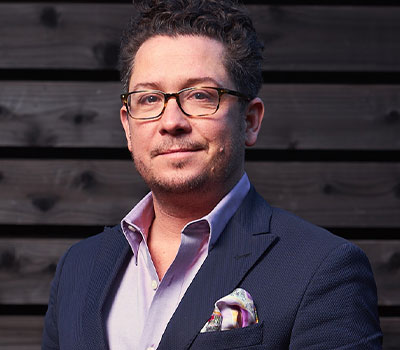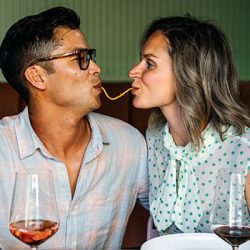Jared Hooper left Los Angeles at the start of the pandemic after serving as wine director at Faith and Flower for many years (and briefly as an editor-at-large for this magazine). He went north to Sonoma County and dabbled in many different roles, helping Evan Goldstein with his Master the World courses, slinging bottles at Barndiva in Healdsburg, and serving as an unofficial brand ambassador for wineries like Native9 and MacRostie. At one point, he says, he was doing five jobs at the same time, until the Farmhouse Inn lured him back to fine dining, where he’s been for the last six months. —Patrick J. Comiskey


LA misses you…
I miss LA! It feels like the city has been making up for lost time, and I was lucky to be around for some of that. LA was literally a joke as a food town—it was like that restaurant scene in LA Story (1991) where no one orders what’s actually on the menu—everyone has a special request. But then it all exploded and literally changed the face of how restaurants operate.
Tell us about the new gig:
The menu is really dynamic, always changing. Trevor Anderson was a former Chef de Cuisine at Alinea and Atelier Crenn. We run a six-course tasting menu with pairings, so much of my work is pairings. I enjoy being back on the floor and executing a chef’s vision.
What’s your approach?
Most of the wine pairing begins with discussion. I will greet guests, find out where they’re at and what they’re looking to do, if they’re coming in from down the block, or for an anniversary celebration, or are they from another part of the world and here to experience northern Sonoma County. The list highlights wines of Sonoma County and the Russian River Valley—we’re just a quarter-mile from the river—but we’re also 100% open to global wines.
What have you done to make it your own?
When it comes to the pairing menu, I’ve instituted what I call my radical personalization program: not mine, the guest’s. I don’t write down my pairings for each course. I have some general ideas of where the pairings will go and have two or more choices for each course.
What are those courses?
We have two menus, Land and Sea, and From the Garden, which includes vegetarian and vegan options. A lot of two-tops will do one of each. Based on that, I often want a wine that will speak to one person’s course but can also reach across the aisle and to each other. Frequently, that means a local wine and an Old-World counterpart. So, white Burgundy and chardonnay, red Burgundy and pinot noir. But we can make other interesting comparisons, like mencía from Spain and the one Mike Roth makes for LoFi, from Santa Barbara County.
It’s an expensive restaurant, and people are here with that in mind. But that affords me a bit of freedom too. I can ask the guest, “What’s the last wine that made you say ‘wow?’” Depending on how they answer that questions, they may have me running to the wine room to pull a cork, and that will be one of the new pairing options for the evening, it’s what we’ll end up pouring by the glass. It all can be done à la minute.
Tell me about one of your greatest hits this year.
I think the Joseph Swan Trenton Estate pinot is one of our biggest sellers. Swan might be the closest winery to us; you take your first right out of the driveway and there it is. Rod Berglund is the winemaker there; we call him the Rodfather. Every year, he and his wife celebrate their anniversary at the Inn. He’s been making wine longer than I’ve been alive. So, I was tasting in his cellar and came across this ’16, from the Trenton Estate, from an old Wente clone Joe [Swan] planted there. Almost no topsoil, all dry-farmed. I told him I need this wine for Farmhouse. He said he’d love to, but that he only made one barrel, and that it wasn’t in distribution. “Sounds like your problem, not mine.” So, I convinced him to drive over a few cases. We’re the only restaurant in world that pours that wine.
How adventurous is your clientele?
If it’s possible, I feel our guests are even more open to trying new things, more than ever I’d say. Is it COVID? Maybe, in some way. It’s been such a major disruption to our lives, and most people have been spending all their time drinking what they know. Coming out of COVID has opened people’s eyes, opened them to the value of trying something new. Part of the fun of wine is there’s always more exploration. I feel like I’ve barely scratched the surface of my own backyard.
Somehow, you managed to find local grenache as well.
Grenache is a grape I love reintroducing people to. I tell them it’s thin-skinned like pinot noir but with more oomph, it just has more weight and strength, like it ran away from home and spent time in juvie. People are comfortable with pinot noir, so it’s a jumping-off point. And this is Chiron Aid and Succor, a Russian River grenache, a total weirdo. The vineyard was just 1.5 acres planted on five-acre property on Fitch Mountain in Healdsburg, in a residential area on wooded rural spot. They only made three barrels, so it’s hyper-local, this fun, crazy, local wine with a great story. It’s the sort of thing we love to sell here, because it can never be repeated.
Patrick J. Comiskey covers US wines for Wine & Spirits magazine, focusing on the Pacific Northwest, California’s Central Coast and New York’s Finger Lakes.
This is a W&S web exclusive. Get access to all of our feature stories by signing up today.



















